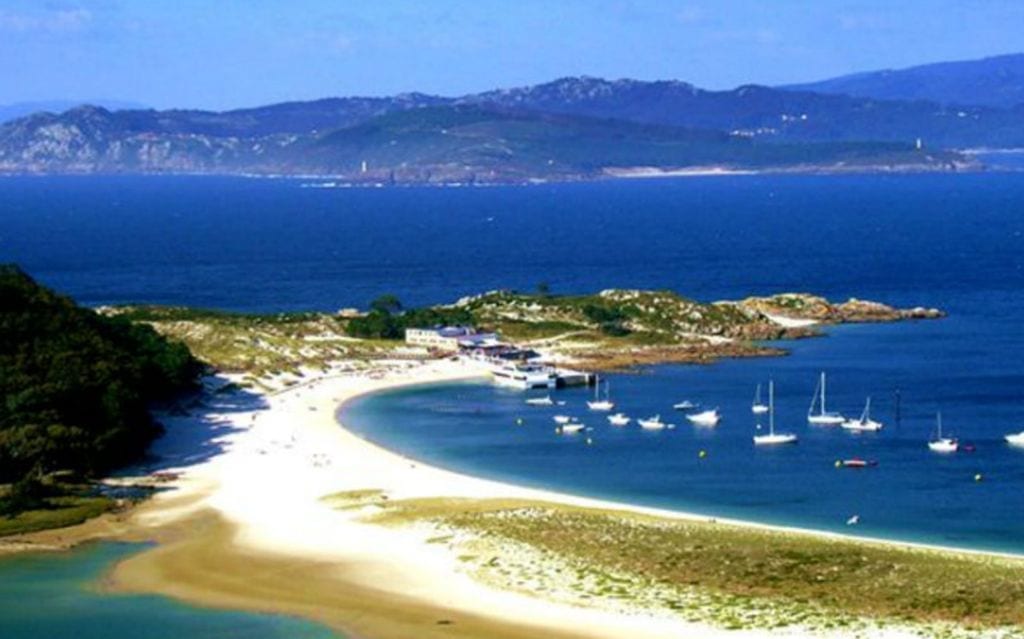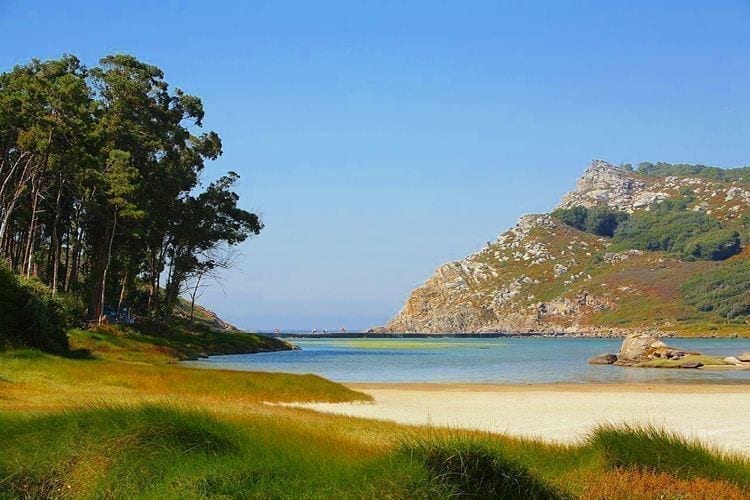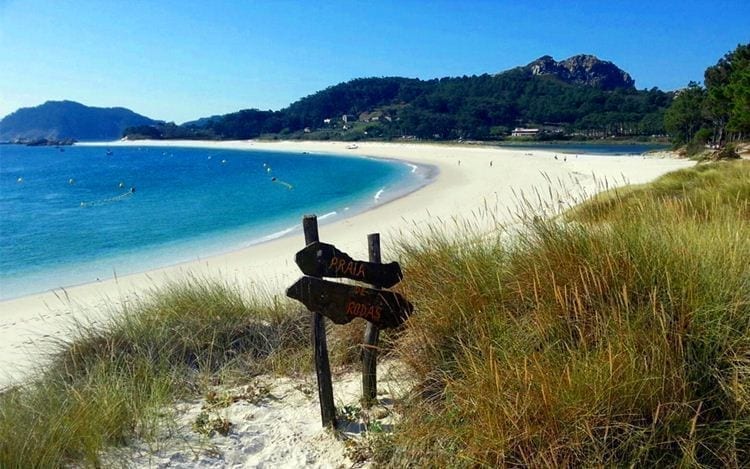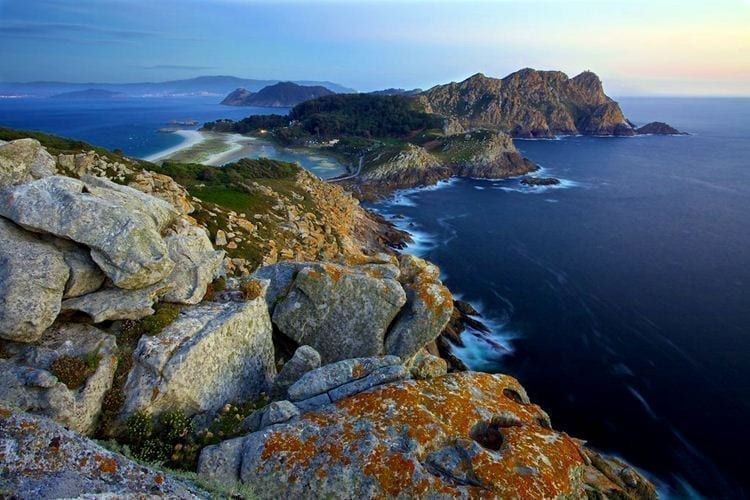The Cíes Islands, a treasure in the Vigo estuary. Located in the province of Pontevedra in the northwest of the Iberian Peninsula, it is part of the Galician Rias Bajas, in Spain. They belong to the National Maritime-Terrestrial Park of the Atlantic Islands of Galicia together with the islands of Ons, Sálvora and Cortegada, and forms a natural barrier between the estuary and the sea. The archipelago is formed by three main islands: Monteagudo or North, Montefaro, joined to the first one by the sandy area of Rodas and San Martiño or South.
A natural environment, full of paradisiacal beaches, the richness in fauna and flora and its incredible landscapes, make this place an important cultural and natural enclave. We must also say that in addition to speaking of the Cíes as nature in its purest state, they offer a good sample of cultural heritage: ruins of monasteries, forts, salting factories and warehouses of the carabineers.
A paradisiacal enclave only 50 minutes from Vigo. The Cies Islands have something special, a unique landscape, a peace that captivates you and even one of the best beaches in the world . An ideal destination if you’re planning a getaway after having made the French Camino de Santiago.
If all this doesn’t convince you to visit this small paradise located in Spain, we will give you all the details about the Cíes Islands that will make you want to visit them.
How to get there?
At the beginning of this post we have talked about where they were located, so we will take as a reference the city of Vigo. Although they appear associated with this city, it is possible to arrive from other ports such as Baiona or Cangas, but the shortest route is from Vigo.
How to get to the Cíes Islands? To go to the Cíes Islands is only possible by boat, there are three options: travel with one of the passenger transport boats that leave from Vigo and Cangas, hire an organised excursion or apply for an anchoring permit on the island and go to the island with your own boat.. These three options are possible during the summerDuring the low season, which takes place in the coldest months of the year, it is only possible to visit the Cíes Islands by hiring an organised trip with the express authorisation of the director of the Natural Park. These ferries will take you directly to the islands of Monte Agudo and O Faro . The third island, San Martiño, can only be reached by private boat, which is also the only way to access the archipelago all year round.
It is a National Park and after the saturation suffered in 2017, there are more tourist restrictions to be able to visit them.. Access is limited to 2200 people per dayIt is therefore advisable before deciding to go, to reserve the permit in advance. The Xunta de Galicia has enabled a specific web to be able to acquire this permit. It can be requested up to 45 days in advance and up to 25 permits can be obtained in the same request. All permits are personal and nominative, so it is necessary to enter the names of the people who are going to visit it.
Sleeping in Cíes. A night in paradise.
Most people who visit the island do it in one day and come back. But if you want to sleep there and wake up seeing the sunrise surrounded by nature and beaches of fine sand and crystal clear water, forget about hotels.
You can only sleep in the Cies Islands in the camping tent. If you want to see the sunset and sunrise on the islands, this is your only option. We advise you to book in advance because there is a limited number of places available.
What can you do in the Islas Cíes?
To talk about Cíes is to talk about nature, so in all the activities we do there, nature will be the protagonist. From visiting its beaches of fine sand and crystal clear water, to observe its fauna and flora or for the more adventurous and active, to make some of its hiking trails.
If we want to do all these activities, one day may not be enough and we recommend booking two or three days to make the most of it .
Beaches
The Cíes Islands have nine beaches of fine white sand and crystal clear waters that allow you to enjoy the tranquility and beauty of its landscapes. Natural enclaves where the traveller will be able to isolate himself from the world and find an incomparable peace. Rodas, Figueiras and San Martiño are the largest beaches, but there are numerous coves such as Areíña, Bolos, Cantareira, Margaridas, Muxieiro and Nosa Señora de Carracido, where you can also escape and get lost. You can’t leave there without visiting the most important ones.
Rhodes Beach
The most visited beach in Galicia and considered by the British newspaper “The Guardian” as the best in the world for its turquoise blue waters so characteristic, its fine white sand and forests that end up reaching the sandy beach. It is the largest and most important beach of the archipelago, and its conditions and services make it ideal to spend the day with the family.
Figueiras Beach
The beach of Figueiras, also called “of the Germans”, located on the island of Monteagudo (North), is the ideal place for the nudist collective, intimacy and freedom characterize this beach. It has white sands, crystal clear water and offers a dreamlike landscape.
San Martiño Beach
It is located on the South Island, and access is only possible by private boat. An extremely majestic landscape with an impressive quality of beaches, very calm waters and white sandy beaches.
Hiking
Hiking around the Cíes Islands is the best way to get to know this natural paradise, integrate into the environment, watch the birds, appreciate its flora and fauna and have the best views from the cliffs and viewpoints. As in the Camino de Santiago, nature will take over us and will make us forget everything.
You can immerse yourself in the environment and fall in love with this magical corner of Galiciaby following one of the four routes available.
Monte Faro Route
This is the most famous and longest route of all. Its route is 7`5 kilometers long and has a medium difficulty due to the slopes. From the Rodas dock we will leave and we will cover most of this route around the island of O Faro until we reach the lighthouse of Cíes. When we arrive we will contemplate the impressive views that its two viewpoints give us, as well as the dune systems, the Lago dos Nenos or the Nature Interpretation Centre.
Alto do Príncipe Route
The entire route will go through Monteagudo Island, through a terrain surrounded by trees. Its length is much shorter than the previous route, only 3`5 kilometers. It is therefore the shortest route and allows us to enjoy both the views and the significant contrast between the two sides of the island. Along this route you will find some points of interest such as the Figueira Muxieiro dune complex, the remains of the Ancient Cuncheiro or the peculiar rock formation of the Silla de la Reina (Queen’s Chair).
Route of the lighthouse of the door
A different point of view, the South Island. This route will go along the south coast of the Lighthouse Island. A route with a distance of 5’2 kilometres, of little difficulty in which we will find O Castro das Hortas.
Route of Monteagudo
Equal in distance to the route do faro da porta, it is 5’6 kilometres long. It offers wonderful views of the estuary from the Faro do Peito. From this point we can see the archipelago of Ons, Cabo Home or Costa da Vela. Along the way we will come across the remains of the Old Cuncheiro, Figueiras Beach or the Bird Observatory.
Additional Activities
If we still want more, these islands never cease to surprise us and continue to offer us endless activities. All of them different and that will leave us a magical memory of the Cíes.
Due to its low light pollution, the national park has been selected as a starlight destination, a name given to those places with certain characteristics. It is possible to make a night excursion in organized groups in which a monitor will accompany us and give us a brief description of the main constellations, planets, etc.
We can’t forget that being surrounded by water, you can’t miss water sports and activities. Among them the most remarkable is diving. The Illas Atlánticas Diving Club offers you to discover the seabed of the National Park. Live the experience and dive in waters that are home to more than 100 different marine species. There are other activities such as snorkeling or kayaking, for this it is necessary to contact some of the companies that offer them.
A picture postcard landscape, the best beach in the world, a natural park practically intact, a dream getaway, what are you waiting for to visit the Cíes Islands?















Leave A Comment